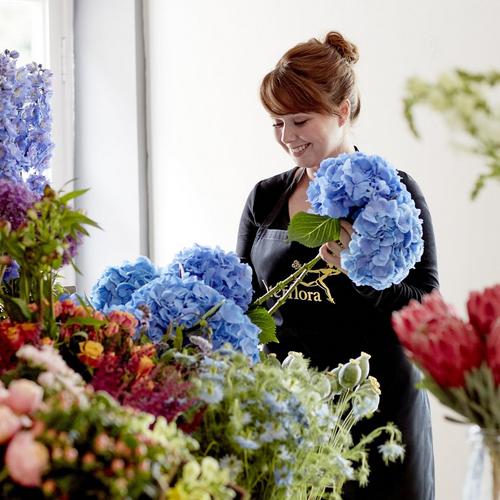The Ultimate Guide to Agapanthus
When you think of a striking flower with an understated beauty, the agapanthus may come to mind. This sun-loving blossom is known for its large, drumstick-headed buds and deep blue hue. It’s also commonly referred to as the African lily or lily of the Nile, although it’s not actually a lily. Read on to uncover some interesting facts about the agapanthus, including its meanings and symbolism, the different types of agapanthus, care tips and more.
Agapanthus meaning and symbolism
It probably comes as no surprise that the agapanthus flower meaning is tied to love. The name agapanthus is taken from the Greek words ‘agape’ (which means love) and ‘anthos’ (meaning flower). This translates to the ‘flower of love’, which is quite fitting for its showy, ethereal appearance. But the agapanthus doesn’t just symbolise love – it’s also seen as an emblem of beauty, purity and fertility.
Interestingly, certain parts of the agapanthus carry different meanings. The roots, in particular, symbolise a healthy baby. In South Africa, the roots are boiled to produce a tonic for pregnant women. They’re also sometimes worn as charms to ensure a baby’s good health and wellbeing.
This fetching flower can also represent beauty in retirement and is commonly featured in funeral wreaths. It’s believed that an agapanthus wreath adorned Queen Victoria’s casket. In fact, the late Queen became fascinated by the Language of Flowers and made some additions to the flower’s meaning. As time went by, the graceful bud carried the meaning ‘love letter’, representing a love that is chaste and pure.
With so many meanings, this alluring blossom can be gifted for a number of occasions – from Valentine’s Day to a christening.
Agapanthus facts
- Agapanthuses first bloomed on the cliffs of the Cape of Good Hope in South Africa and were brought to Europe in the 17th century.
- The agapanthus is a member of the Amaryllidacae family and has around 10 species under its genus. There are two types of agapanthus – deciduous and evergreen. The deciduous varieties originate from colder regions and are generally hardier than evergreen varieties.
- Agapanthus flowers range in height, with some growing to 20-60cm (up to around 2ft) and others growing up to 1.5m (5ft). On average, they reach their mature size in around 3-5 years.
- Some agapanthus varieties are considered too invasive in certain countries. The Praecox variety is classed as an environmental weed in New Zealand. However, the move to have it added to their National Pest Plant Accord has been opposed by gardeners.
- Despite its common names, African lily and lily of the Nile, agapanthuses are actually related to garlic, Galanthus and Narcissus.
- In South Africa, the agapanthus was used as both a medicinal plant and as an aphrodisiac. Some varieties were used to treat colds, chest pains and heart-related conditions.
Types of agapanthus
The agapanthus flower is characterised by its rounded flower head and incredible purple hues. However, there are many types of agapanthus, and some of them come in blue, pink and white tones.
Blue agapanthus
Purple agapanthus
White agapanthus
Pink agapanthus
When to plant agapanthus
Once you know how to get agapanthus to bloom, everything else falls into place. The agapanthus flower thrives in moist but well-drained soil in full sun. But the rules are different depending on how you decide to grow them.
- Borders – It’s best to plant agapanthus flowers in the border during spring. For bulbs or rhizomes, the noses should be covered with 2 inches of soil. However, it’s best to grow agapanthus in containers if you live in a cold area, or your soil is prone to waterlogging.
- Containers – Agapanthus flowers should be grown in 8-inch containers using a loam-based compost, such as John Innes No. 2 or No. 3. Most agapanthus flowers grown in containers benefit most from winter protection.
How to care for Agapanthus
Watering
Agapanthus flowers should be watered regularly in their first year of planting. Once they’ve finished growing, they will need little watering. However, some varieties may need help in the summer on particularly dry days.
Feeding
Feed border agapanthus flowers in spring with a balanced fertiliser, such as Vitax Q4, Growmore or fish, blood and bone. For agapanthus in containers, use a liquid fertiliser – such as Phostrogen or seaweed feed – and feed fortnightly until the flowers begin to show colour.
Deadheading
When the agapanthus flowers have faded, it’s a good idea to cut them off at their base to encourage the plant to flower longer. For deciduous types, remove the flowered stems and yellowed leaves in the autumn. In comparison, evergreen leaves can be taken off at any time.
When does agapanthus bloom?


Creating an agapanthus bouquet
The illustrious lily of the Nile is anything but simple. Not only are they elegant on their own, with delicate petals and graceful foliage, but they also add beauty and flair to any bouquet. That makes them ideal for a well-balanced arrangement.
As beloved ornamental flowers, agapanthus combine well with sunflowers, pink germini, orange lilies and rich foliage – as demonstrated in our summer flowers blog. They also make a great companion for other summer flowering perennials. Verbena bonariensis, Mexican feathergrass, asters and Echinacea purpurea, to name a few.
To create this summery bouquet, follow these simple steps:





%20(1).jpg?$poi-square$&fmt=auto&qlt=default&fmt.jp2.qlt=60&bg=rgb%28254%2C+204%2C+167%29&w=960&aspect=16%3A9)

